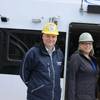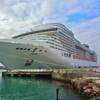Big Ideas Sometimes Come in Small Packages
Hyde Marine’s chemical-free, IMO Type Approved ballast water treatment solution packs performance in a smaller footprint. That’s good news for small vessel operators who may soon find themselves impacted by a problem that previously was thought to be a “bluewater” issue.
BWT and Brown Water
The notion that ballast water treatment and invasive species are both strictly the domain of big, bluewater liners coming from the Far East and other exotic locales quickly went out the porthole last November when the Environmental Protection Agency (EPA) issued its long-awaited, updated draft Vessel General Permit (VGP) rule. The new rules potentially bring regulations to bear on vessels as small as 79 feet LOA and others, depending on service and routing. Separately, a recent workshop conference held at Duke University in January also highlighted the need for the world’s research fleets to lessen their environmental footprint. Those efforts include the installation of ballast water treatment systems for smaller hulled research platforms. Prominently mentioned at the conference, also attended by MarineNews Editor Joseph Keefe, was the leadership of Hyde Marine in this effort.
Good News (at last)
As this issue of MarineNews went to press, the Office of Management and Budget (OMB) completed its review of the Coast Guard's Ballast Water Discharge Standard regulations in accordance with Executive Order 12866, and changed its designation from an Interim Final Rule to a Final Rule on February 24, 2012. The Coast Guard is preparing it for publication in the Federal Register, and expects to complete the administrative process within 30 days – or by the end of March.
John Morris of the U.S. Coast Guard's Environmental Standards Division said in a prepared statement, "We are not at liberty to discuss details of the rule until it is actually published, but wanted to clear up confusion about its status.” At press time, then, the exact BWT standard was not yet public, but the fact that the final rule had been decided at long last, was indeed settled. That’s good news.
Separately, in February, the New York Department of Environmental Conservation (NYSDEC) issued a press release stating that it will pursue a uniform national ballast water standard by leaving in place the EPA’s current standards in New York for the remainder of EPA’s current Vessel General Permit through December 2013. New York’s decision to (at least temporarily) release its hold on a standard that is unattainable and one which no technology yet exists to measure its efficacy, is very good news. The move also gives hope that a national standard can be achieved at some point in the future. Both the American Great Lakes Ports Association and Transport Canada applauded the decision.
Ahead of all the news is Hyde Marine.
Hyde Marine: Early Entry + Deep Experience = Real Success
Hyde Marine, once a small, Cleveland, Ohio-based company, recognized early the need for shipboard ballast water treatment as the effect of zebra mussels and other invasive species in the Great Lakes region gained attention. Today, Hyde Marine is a division of Calgon Carbon Corporation (NYSE:CCC), with corporate headquarters and production facilities in Pittsburgh, PA. That relationship is nothing but good news for Hyde, especially in a business where the wherewithal to outlast the prolonged regulatory process and the need to assure customers that service will be available long after the sale are both paramount.
In 1997 Hyde was selected to provide engineering services for the Great Lakes Ballast Water Demonstration Project and tasked with evaluating and assembling a collection of filtration and disinfection technologies that could be combined to remove or kill organisms from ships ballast water. Hyde engineers brought more than 20 years experience with ballast tank sediment management (Hyde Mud Remover) and industrial wastewater filtration and wastewater treatment systems to this project.
Hyde’s experience with various filtration techniques eventually produced a UV disinfection system that was practical, safe, and an environmentally sound method to treat ballast water. Simply designed, safe, and reliable, the efficient, automatic backflushing filter is used to remove sediment and larger plankton, and a powerful UV disinfection system destroys or inactivates smaller organisms and bacteria.
Hyde’s early efforts included delivery of five prototype treatment systems, utilizing cyclonic separation and low pressure UV, on board vessels in 2000 and 2001. As the IMO BWM convention began to take shape, Hyde recognized that the performance and reliability of the treatment components needed to be improved. They also knew that equipment size would be critical, not only for the retrofit bluewater market, but for smaller hulls with even tighter cubic dimensions.
By 2002, Hyde had completed development of a two step treatment process of stacked-disk depth filtration and medium pressure UV treatment which was delivered and installed on the M/S Coral Princess in 2003. This Hyde GUARDIAN system was put into service and became the first to be accepted into USCG STEP and in April 2009 became one of the first systems to achieve IMO Type Approval.
Proven Track Record
As one of the first commercially available and fully approved treatment systems, Hyde began to receive orders for GUARDIAN systems primarily for new construction projects and for a wide range of vessel types and sizes. Today, Hyde has orders for over 175 treatment units on vessels with ballast pump capacities ranging from 50 to 5,500 cubic meters per hour. With that kind of scalability, Hyde is in a unique position to offer approved systems for smaller vessels. Hyde recognized this need when approached by the Dutch biological research team about fitting the system to R/V Pelagia, a 66 meter multipurpose research vessel. The research team had been impressed by what they saw, particularly the reliability of the self cleaning filters, during IMO G8 testing under extremely challenging conditions at the NIOZ test facility, and specified the Hyde Guardian to be purchase and installed on their own ship.
The Pelagia was the first of many research vessels and workboats that have selected the Hyde system, in what has become an important niche market for Hyde. As much as 10 percent of Hyde’s current projects are on research vessels, smaller cargo ships and passenger vessels. Beyond this, more than 35 percent of Hyde GUARDIAN projects have been in the Offshore Service Vessel market sector.
Small Vessels: Big Challenges
According to Hyde’s Jim Mackey, Key Accounts Manager for Hyde, smaller vessels have many unique challenges when it comes to ballast water treatment system installations. These include:
Space: Space is at a premium on smaller vessels, especially for retrofitting equipment into existing boats. Suitable treatment systems must have a flexible design and be compact and modular so that treatment components, control panels and piping can be installed where space allows.
Operation in high sediment conditions: Shallow water, fresh water, and rivers with high sediment create extreme challenges for ballast water treatment technology, particularly for the filtration system. High sediment and organism content can easily cause plugging and can overwhelm a filter’s self-cleaning process. The result is stopping the ballasting process while filters are manually cleaned. To avoid this, the Hyde GUARDIAN includes unique stacked disk filters, which automatically backwash with high pressure water jets when needed.
Short(er) ballast holding time: Passenger ferries, offshore supply vessels and small cargo vessels often operate on short trade routes, requiring frequent ballast operations. This requires a BWT process that effectively kills the organisms without requiring residency time in the tanks. UV disinfection inactivates organisms by destroying their DNA as the water flows through, but does not change the water in any way so it can be discharged at any time. The latter point is especially critical in terms of discharging in U.S. waters, in light of the new, proposed EPA VGP.
Cold Weather (Arctic) Ops: Vessels operating in northern climates, on the Great Lakes, and those designed to support Arctic oil E&P operations must be capable of ballasting in cold water conditions. Unlike electro-chlorination, medium pressure UV is not affected when the water temperature drops below approximately 5 degrees C.
Environmentally Sensitive Areas & OPS: Smaller vessels often operate in remote, unique ecological locations, intensifying the need to minimize risks of pollution. Oil and Gas operations are pushing into more remote and pristine environments while Research vessels, small passenger and expedition yachts operate in locations where protection of the ecosystem is of utmost concern.
Recent Smaller Hull Orders
Hyde continues to deliver BWT systems even in this challenging financial climate on the waterfront. Recently a Hyde system was delivered to Edison Chouest Offshore for the Icebreaking AHTS that is under construction at North American Shipbuilding (Hull 247).
Additionally, a Hyde Model HG60 will soon be delivered for retrofit on the "Ranger III," a Small Passenger Vessel operated by the National Park Service (NPS) in Lake Superior, USA. Due to stability limitations, the Ranger III must carry ballast during each crossing. Significantly, and according to NPS, the vessel’s operating season is subject to ice conditions on Lake Superior, The NPS intends to install the system during winter lay-up, between October 2011 and March 2012.
On another front, Hyde has delivered another BWT system to the Polar Supply and Research Vessel S.A. Agulhas II. Operated by the South African Department of Environmental Affairs, the vessel will function as a multi-purpose vessel, serving, among other things, as a supply vessel, research vessel, icebreaker, expedition vessel, as well as a passenger ship. Operating in a particularly sensitive area, the Polar Supply and Research Vessel will be used to carry scientists and research equipment between South Africa, the Antarctic islands and the Antarctica.
Decisions and Questions – for Smaller Hull Operators, too
At a time when the ballast water regulations dance appears to finally be winding down, the domestic situation in the United States also moves towards some sort of closure. And, while that may remove some headaches for foreign flag, bluewater, deep draft operators who would like to move ahead with compliance installations, the waters are muddier (no pun intended) for domestic, smaller vessel operators. Risk remains for operators to install any system in advance of the final VGP regulations. And, there is no guarantee, says a Coast Guard source, that the two federal standards – EPA and U.S. Coast Guard – will ever be married.
As the issue plays itself out, here and abroad, Hyde remains deeply involved with not only delivering proven systems to a myriad of operators, but also in the regulatory and research process itself. Tom Mackey, Senior Consultant at Hyde Marine recently chaired a ballast water technology conference in the UK. With speakers coming from a dozen countries; and attendees from a wider demographic, including the U.S. Coast Guard, the conference was timed to ensure robust attendance of those also coming to London for IMO’s Marine Environment Protection Committee 63rd session (MEPC 63) during the following week.
Across the breadth of all markets, the issues of safety of vessel and crew (chemical hazards), and more recently, the increased risk of corrosion in ballast tanks due to residual chemical oxidants from some treatment processes are all in play. According to Hyde Marine, the choice of a non-chemical ballast water treatment technology will help to mitigate these risks.
Ballast Water Treatment is no longer the primary domain of the deep draft, ocean-going vessel. As the rules impinge upon smaller hulls in niche markets, Hyde Marine continues to help customers navigate the turbulent waters of pending ballast water treatment regulation. At the same time, they have delivered scores of effective, smaller footprint and environmentally correct systems a wide range of players. Someday, you could be one of them. www.hydemarine.com.
- Editor's NOTE: The Coast guard's new standard has been published.
By Joseph Keefe - Editor, MarineNews (Taken from MarineNews March 2012 print edition)













